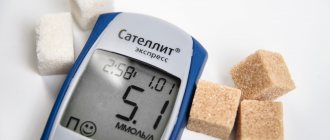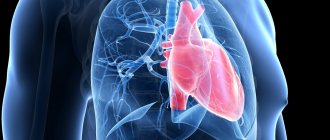Full text of the article:
Diabetes mellitus, or “sugar,” affects people of all ages. We have learned to live with this diagnosis and identify it in the early stages. However, the likelihood of early diagnosis of the disease is possible only with regular preventive examinations by a doctor. To begin with, we suggest you understand what diabetes mellitus can be.
T1DM
There are two types of diabetes mellitus. Type 1 diabetes mellitus (T1DM) develops at a young age. The cause of the disease is an absolute lack of insulin in the body, which occurs due to the destruction of beta cells of the pancreas. Type 1 diabetes mellitus most often appears after treatment of an infectious disease or severe stress. The patient experiences severe thirst, increased urination, weakness, and weight loss. The disease progresses rapidly and may be accompanied by loss of consciousness. The patient needs medical care in a hospital.
The essence of type 2 diabetes
The main difference between type 2 diabetes is the immunity of body cells to the action of the hormone insulin, i.e. their insulin resistance. In a healthy person, insulin “instructs” the cell membranes of various tissues to “let in” glucose, the main source of energy. In a patient with type 2 diabetes, the cells do not perceive the “commands” of insulin, and the membrane remains “locked.”
In patients with type 2 diabetes, insulin cannot open the glucose lock
As a result:
- The tissues of various organs do not receive the energy necessary to perform their functions normally.
- The glucose content in the blood exceeds the norm (hyperglycemia occurs), which most unfavorably affects the ability of the main fluid of our body to transport oxygen from the lungs to the tissues, and carbon dioxide from the tissues to the lungs.
- The liver, which normally always stores a “strategic reserve” of glucose, responds to “requests for help” from starving cells of skeletal muscles, brain, heart, etc. And releases the “stored” sugar into the blood, further increasing its content in it.
- The insulin-producing “islands” in the pancreas work “overtime” in response to high blood sugar. Over time, this leads to their depletion and loss of their secretory functions.
T2DM
Type 2 diabetes mellitus (T2DM) most often affects people over 40 years of age. This form of diabetes is characterized by relative insulin deficiency. For a long time, the disease may not manifest itself at all; symptoms appear gradually, so people often seek help late. Over time, the patient may need insulin therapy. Type 2 diabetes mellitus is treated mainly on an outpatient basis.
The risk of developing T2DM is higher in the following groups of people:
- age over 45 years;
- overweight (body mass index more than 25 kg/m²);
- high blood pressure (arterial hypertension, above 140/90 mm Hg);
- genetic predisposition (close relatives suffer from T2DM);
- low physical activity;
- elevated blood triglyceride levels (≥ 2.82 mmol/L) and decreased HDL cholesterol levels ≤0.9 mmol/L.
For people who are at risk, doctors recommend doing a blood test at least once a year and monitoring their glucose levels.
Symptoms of T2DM
Type 2 diabetes mellitus does not have specific symptoms that can clearly identify the disease, but the appearance of several symptoms of the disease at the same time may be a sign of the development of T2DM. Check if you have three or more symptoms from the list below, this is a reason to see a doctor:
- you feel dry in your mouth and constantly thirsty;
- you have excessive urination, including at night;
- your skin and mucous membranes are itchy;
- you quickly get tired and feel weak;
- your wounds and skin damage are healing slowly;
- pustules appear on the skin;
- you have lost a lot of weight and suddenly for no apparent reason.
What to do if you suspect you have T2DM?
If you feel unwell and experience symptoms of diabetes, the first thing you should do is consult a doctor. An examination performed by a therapist or general practitioner will help identify T2DM. To register at the clinic, you will need a passport and compulsory medical insurance policy. The doctor will decide on the need for further examination based on the results of the examination.
The following tests help identify T2DM:
- general blood analysis;
- general urine analysis;
- biochemical blood test with blood glucose testing;
- biochemical blood test to assess lipid metabolism disorders;
- determination of the level of glycated hemoglobin in the blood;
- oral glucose tolerance test.
All of the above tests can be done at the clinic at the site of attachment. The results will be ready 1-2 days after submission. The diagnosis may be as follows:
- diabetes mellitus has not been confirmed, but there are factors for its development;
- prediabetes was detected;
- type 2 diabetes mellitus was diagnosed.
When to see a doctor
An endocrinologist deals with the diagnosis and treatment of type 1 and type 2 diabetes mellitus. At JSC "Medicine" (clinic of academician Roitberg), which is located at 2nd Tverskoy-Yamskaya per. 10, you can find first-class specialists. As soon as the first signs of diabetes mellitus appear in women or men, it is necessary to go to the hospital.
Symptoms of diabetes mellitus in men and women are usually expressed in strong and frequent thirst, frequent urination (especially at night), sudden weight loss, and increased appetite.
If the diagnosis is not confirmed
If the examination did not confirm the presence of diabetes, but identified factors for its development, then you need to be attentive to your health and not neglect prevention. Don't forget that prevention is always better than cure. Patients at risk are advised to follow a diet, lead an active lifestyle and have their blood glucose tested once a year.
If prediabetes is detected
Proper diet and lifestyle can help delay or prevent the onset of diabetes. Prediabetes indicates an early disorder of carbohydrate metabolism. Signs of prediabetes include impaired fasting blood glucose and impaired glucose tolerance. Patients are advised to consume less easily digestible carbohydrates and increase physical activity. In addition, it is recommended to be examined by a therapist at least once a year and have your blood glucose tested.
If you have been diagnosed with type 2 diabetes mellitus
Once the diagnosis of diabetes has been confirmed, treatment should not be delayed. First, you need to go to an appointment with an endocrinologist to clarify the concomitant pathology and select individual treatment. A referral to an endocrinologist will be given by a therapist or general practitioner if, as a result of the examination, it turns out that the level of blood glucose in venous plasma exceeds 7.0 mmol/l, and glycated hemoglobin is higher than 6.5%. The endocrinologist determines the individual target level of glycated hemoglobin (HbA1c) for the patient and develops glucose-lowering therapy based on the examination results and the presence of concomitant diseases.
Additional examinations
An endocrinologist may prescribe additional examinations for the patient. This is necessary to anticipate possible complications of T2DM. As an additional examination, the endocrinologist may refer the patient to an ophthalmologist to check the condition of the fundus and evaluate visual acuity at the time of diagnosis of type 2 diabetes.
There are a number of mandatory examinations that a patient with T2DM must undergo every year. These include ECG and chest x-ray. If indicated, the patient may be referred for additional examinations:
- See a cardiologist for arterial hypertension and dyslipidemia;
- See a nephrologist or urologist for kidney pathology;
- See a neurologist if you complain of loss of sensation in the limbs and poor wound healing.
Selection of treatment and free medications
The treatment program for the patient is drawn up by an endocrinologist. There is no standard program, since treatment is selected taking into account the patient’s lifestyle, the presence of concomitant diseases and a tendency to hypoglycemia. While the selection and correction of insulin therapy is underway, the patient should regularly visit an endocrinologist.
It is useful to know that patients with diabetes can receive preferential drug coverage; benefits apply to:
- hypoglycemic drugs and other medications prescribed by your doctor;
- means for administering insulin;
- means for self-monitoring of glycemia;
- consumables for insulin pump.
Medicines can be obtained with a prescription from a doctor. They are issued at the pharmacy of the clinic to which the patient is assigned. Prescriptions are issued for a period of no more than 90 days. If the drug is not available, the prescription is registered in a special journal in the prescribed form, and the drug is delivered to the point within 10 days.
Prevention
To prevent the development of diabetes, you must:
- normalize body weight;
- constantly practice moderate physical activity, play sports, walk in the fresh air;
- switch to a healthy diet, which involves eating plenty of fruits and vegetables;
- promptly treat pancreatic diseases.
People with obesity, frequent stress, and poor diet need to be especially careful. Diabetes mellitus is also possible during pregnancy.
Evaluation of treatment effectiveness
The effectiveness of the prescribed treatment must be monitored and, if necessary, the treatment program adjusted. In addition, it is important to identify emerging complications at an early stage. To do this, patients are recommended to check glycated hemoglobin every three months, microalbuminuria (MAU) every six months, and undergo a clinical examination once a year.
Patients with diabetes mellitus of the first group are registered with an endocrinologist, and patients with T2DM, after selecting appropriate therapy in the absence of severe cardiovascular diseases, are observed by a therapist or general practitioner. If the patient's condition worsens, the therapist can re-refer him to an endocrinologist to adjust the therapy. If the complications that arise lead to a person’s loss of ability to work, he is assigned a disability, but this is done on the basis of the conclusion of a medical and social examination.
Complications
If a person has diabetes, this can lead to serious consequences. First of all, the immune system deteriorates greatly. Because of this, for various diseases, recovery lasts much longer, and chronic pathologies appear.
Wounds heal much worse. Blood vessels and nerve tissues are also affected. Atherosclerosis gradually develops. Possible damage to the kidneys and eyes.
Another complication is diabetic foot syndrome. This area of the limb is considered the most vulnerable place for diabetes. Pathological changes can lead to inflammation, ulcers, and necrosis. In advanced cases, the leg may be amputated.
Global threat to all humanity
It is no coincidence that World Diabetes Day is celebrated on November 14th. It was on this day that the Canadian doctor Frederick Banting , the discoverer of insulin, was born, who in 1922 gave the first insulin injection to a patient in history, and in 1923 received the Nobel Prize for his discovery. Since then, much research has been carried out in world medicine and pharmaceuticals on the treatment and prevention of this terrible disease, but every year the problem of the spread of diabetes mellitus on a global scale is becoming more acute. According to WHO, over the past 30 years, the prevalence of diabetes mellitus has been growing along with the prevalence of obesity and overweight: in 1980, 108 million people with diabetes were registered in the world, and by 2014 their number had already increased to 422 million. The incidence of diabetes is growing especially rapidly in low- and middle-income countries.









